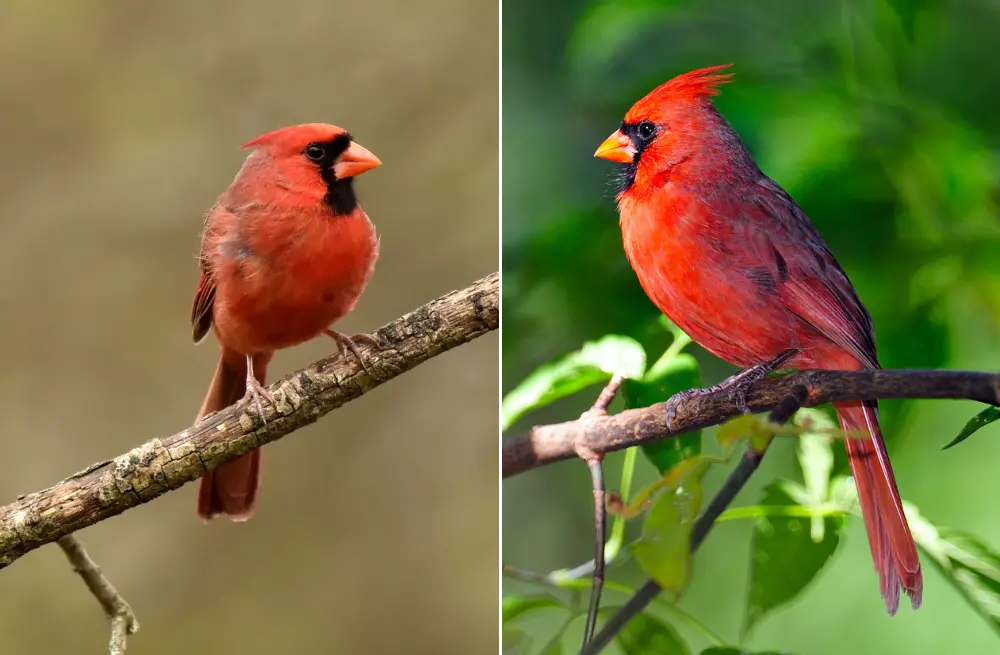The red-legged partridge (Alectoris rufa) is an enchanting gamebird that belongs to the pheasant family. With its rotund body, light brown back, and striking red legs, this bird stands out in its natural habitat. It is often referred to as the French partridge to differentiate it from the English or grey partridge.
The genus name “Alectoris” originates from the Ancient Greek word for farmyard chicken, reflecting its close association with domesticated birds, while “rufa” comes from the Latin word for red or rufous, highlighting the distinct coloring of its plumage.
In this article, we will delve into the fascinating world of the red-legged partridge, exploring its habitat, behavior, diet, and more. So let’s dive into it!
Physical Features of Red-Legged Partridges
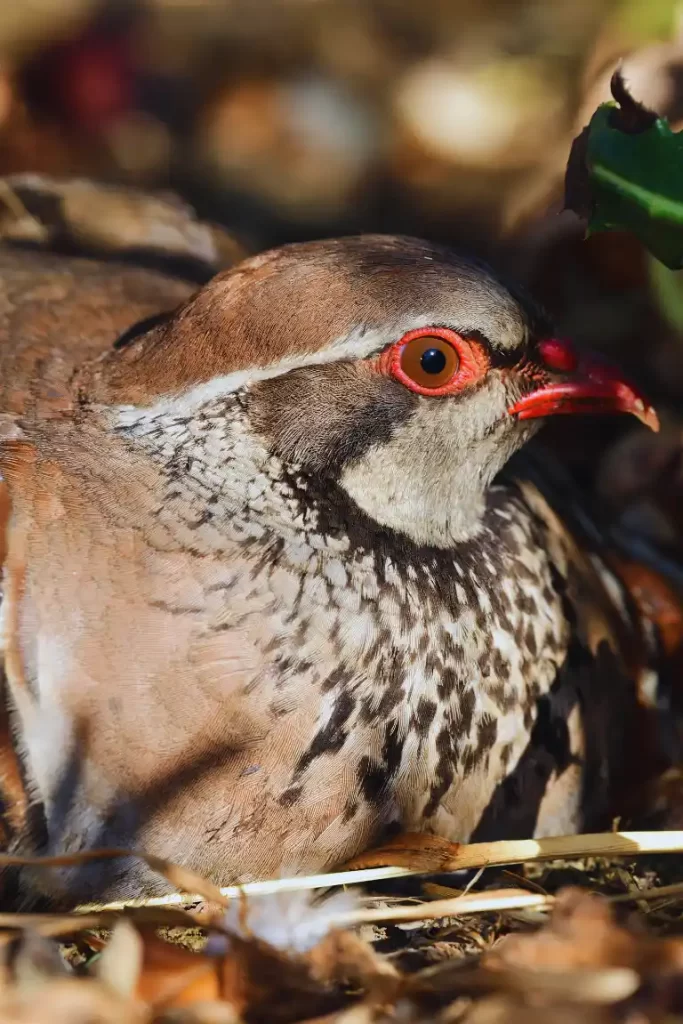
Red-legged partridges are fascinating birds with unique physical features. Their reddish-brown plumage, distinct black bars, and striking red legs make them a sight to behold.
The patterns and colors serve various purposes, including camouflage, mate attraction, and communication within their species.
Here, we will delve into the physical characteristics of red-legged partridges, exploring their plumage, legs, and other defining traits. Understanding these features will give us a deeper appreciation for these beautiful birds.
Plumage: A Closer Look at their Feathers
The plumage of red-legged partridges is primarily reddish-brown on their heads, necks, and upper bodies. Males typically exhibit more vibrant colors and distinct markings compared to females.
Their plumage is adorned with striking black bars and patches, creating a visually appealing pattern. These intricate patterns serve multiple purposes, including camouflage in their natural habitat.
Red Legs: A Distinctive Trait
As their name suggests, red-legged partridges have reddish legs, which are a notable characteristic of the species. The vivid red color of their legs sets them apart from other bird species and adds to their overall charm.
The reason behind the red coloration is still a subject of study, but it is believed to be associated with sexual selection and signaling fitness to potential mates.
Facial Features: Crown, Eye Ring, and Gorget
In Scotland, red-legged partridges have additional distinctive features on their heads and necks. The crown and upper nape display a warm pinkish-brown color, while the fore crown and lateral edges of the crown appear pale blue-grey.
They have a narrow off-white supercilium, which runs from above the lores to the sides of the lower nape. The eye is surrounded by a bright red eye ring, adding a touch of brilliance to their facial appearance. The throat area features a solid black gorget, which enhances their overall visual appeal.
Body Patterns: Flanks, Breast, and Belly
The flanks of red-legged partridges are marked with bold rufous-brown bars, typically numbering between eight and ten. Each bar has a narrow black leading edge, with an off-white background in front of each bar and a pale grey color behind.
These distinct patterns on their flanks provide them with additional camouflage and help them blend into their surroundings. The breast is pale blue-grey, while the belly is pinkish-buff, creating a contrast to the darker plumage of their upper body.
Beak and Eyes: The Fine Details
The beak of red-legged partridges is bright red, contrasting with their plumage. Their eyes have a medium brown iris, adding depth and expression to their faces. These finer details contribute to their overall appearance and play a role in their communication and visual signaling.
Habitat and Distribution: Where do Red-Legged Partridges live?
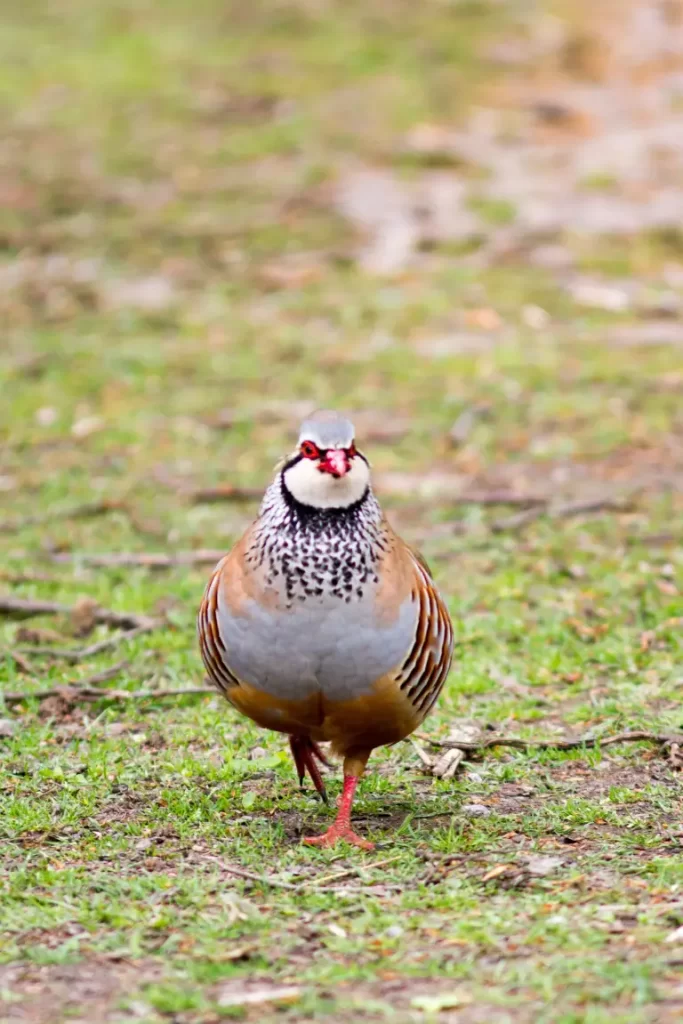
The red-legged partridge (Alectoris rufa) is a bird native to southwestern Europe, renowned for its adaptability to various habitats. Let’s take a look at the preferred habitats and distribution of this beautiful species, shedding light on its versatility and geographic range.
Versatile Habitat
Red-legged partridges exhibit a remarkable ability to thrive in diverse environments. They can be found in open farmlands, grasslands, scrublands, and even mountainous regions. This adaptability is one of the key factors contributing to their success and widespread distribution. The species showcases its resilience by making the most of the available resources in different habitats.
Native Range
The red-legged partridge is native to southwestern Europe, specifically France, Iberia (Spain and Portugal), and northwest Italy. These regions serve as the primary breeding grounds for this species. The favorable climatic conditions and suitable habitats in these areas provide an ideal environment for their reproduction and survival. They have coexisted with the local ecosystems for centuries, adapting to the unique characteristics of each region.
Introduced Populations
Beyond its native range, the red-legged partridge has been introduced to other regions, including parts of the United Kingdom, where it was introduced as a game species. These introductions were mainly for sporting purposes, allowing enthusiasts to engage in hunting activities. The species has managed to establish populations in flat areas of England and Wales, and there have even been sightings of breeding individuals as far north as Sutherland. These introduced populations have adapted to the local conditions and have become part of the landscape in these areas.
Nesting Habits
Red-legged partridges are terrestrial birds that prefer to breed in dry lowland areas. They construct their nests on the ground, utilizing natural depressions or vegetation for protection and concealment.
The ground nests provide a secure environment for incubating their eggs and rearing their young. Interestingly, there have been observations of red-legged partridges cohabiting with wild rabbits, potentially benefiting from the burrow systems created by these animals.
Non-Migratory Behavior
The red-legged partridge (Alectoris rufa) is an intriguing bird species with a non-migratory lifestyle. Unlike many migratory birds, these partridges do not undertake long-distance movements or seasonal migrations.
However, outside the breeding season, they engage in a remarkable behavior – they come together and form flocks, showcasing their gregarious nature. These flocks offer several advantages, including increased protection against predators and improved foraging efficiency.
Flocking Behavior and Social Cohesion:
Outside the breeding season, red-legged partridges exhibit a natural inclination to gather and form flocks. This behavior is driven by their social instincts and the benefits of collective living.
The flocks can range in size from small groups to larger gatherings, with individuals actively interacting and cooperating with one another. This social cohesion fosters a sense of community among the partridges.
Enhanced Protection against Predators:
One of the key benefits of flocking for red-legged partridges is the increased level of protection it provides against predators. By coming together in numbers, these birds create a collective defense mechanism.
When potential threats approach, such as birds of prey or ground predators, the members of the flock can alert each other and respond more effectively. With multiple pairs of eyes scanning the surroundings, the chances of detecting predators early are significantly heightened.
This early warning system allows the partridges to take evasive action or seek refuge together, increasing their chances of survival.
Behavior and Social Structure
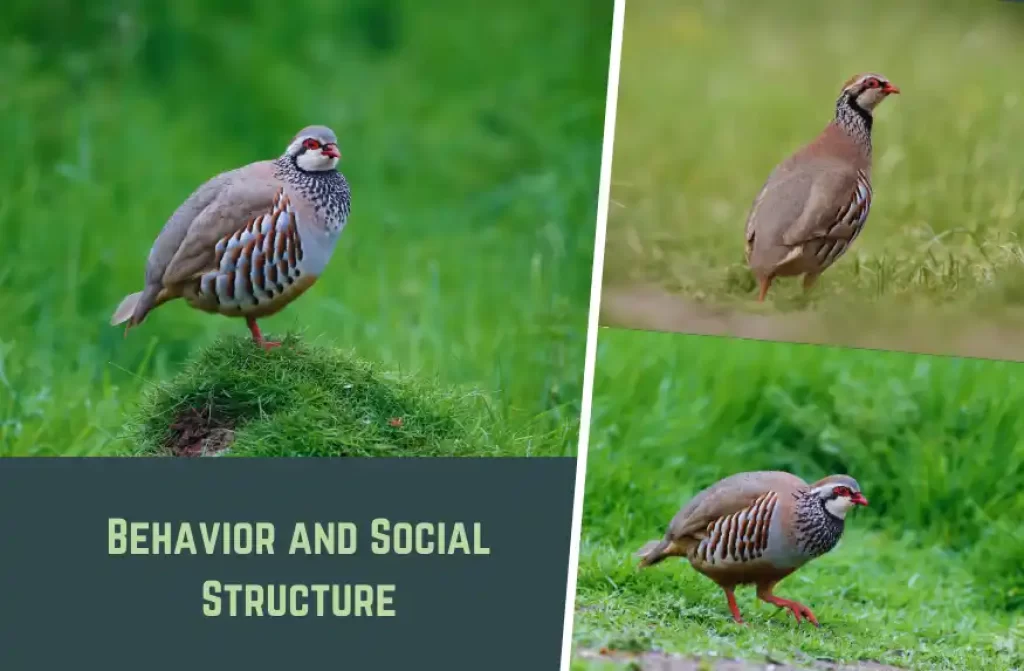
Red-legged partridges (Alectoris rufa) are highly social birds that exhibit fascinating behavior and establish complex social structures. Let’s delve into their behavior and social dynamics to gain a deeper understanding of these captivating birds.
Coveys and Social Hierarchy
Red-legged partridges often form coveys, which are small flocks consisting of several individuals. These coveys provide a sense of community and enable the partridges to thrive in their environments. Within these groups, a hierarchical structure emerges, with dominant individuals establishing their authority.
The dominant individuals hold the highest social status and have access to preferred resources, such as prime foraging areas and potential mates.
Lower-ranking individuals may face competition for resources and may have to be more submissive to maintain their place within the social hierarchy.
Mating Rituals and Courtship Displays
During the breeding season, red-legged partridges engage in elaborate mating rituals. The male partridges showcase their vibrant plumage and distinctive features to attract a mate.
They perform impressive courtship displays, which involve various behaviors such as puffing out their feathers, spreading their wings, and bobbing their heads.
These visual displays, coupled with vocalizations, serve as signals to communicate their fitness and readiness to mate. The female partridges carefully observe these displays and select a mate based on the male’s attractiveness and display quality.
Communication and Vocalizations:
Red-legged partridges rely on communication to coordinate within their groups and convey important information. They utilize a range of vocalizations, including calls and alarm signals, to communicate with one another.
Each vocalization serves a specific purpose, whether it’s a contact call to maintain group cohesion or an alarm call to warn others of potential threats.
These vocalizations are crucial for group coordination, ensuring that the partridges can stay together, navigate their environment, and respond effectively to changes or dangers.
Group Coordination and Warning Signals
Within the coveys, red-legged partridges demonstrate a remarkable ability to coordinate their actions. Through their vocalizations and body language, they can communicate their intentions and share information with other group members.
This coordination is essential for activities such as foraging, predator avoidance, and maintaining group cohesion during movements.
When a potential threat is detected, such as a predator approaching, the partridges emit alarm signals to alert others in the group. This rapid warning system allows the entire group to react swiftly and take appropriate evasive action, increasing their chances of survival.
Diet and Feeding Habits: What do red-legged partridges eat?
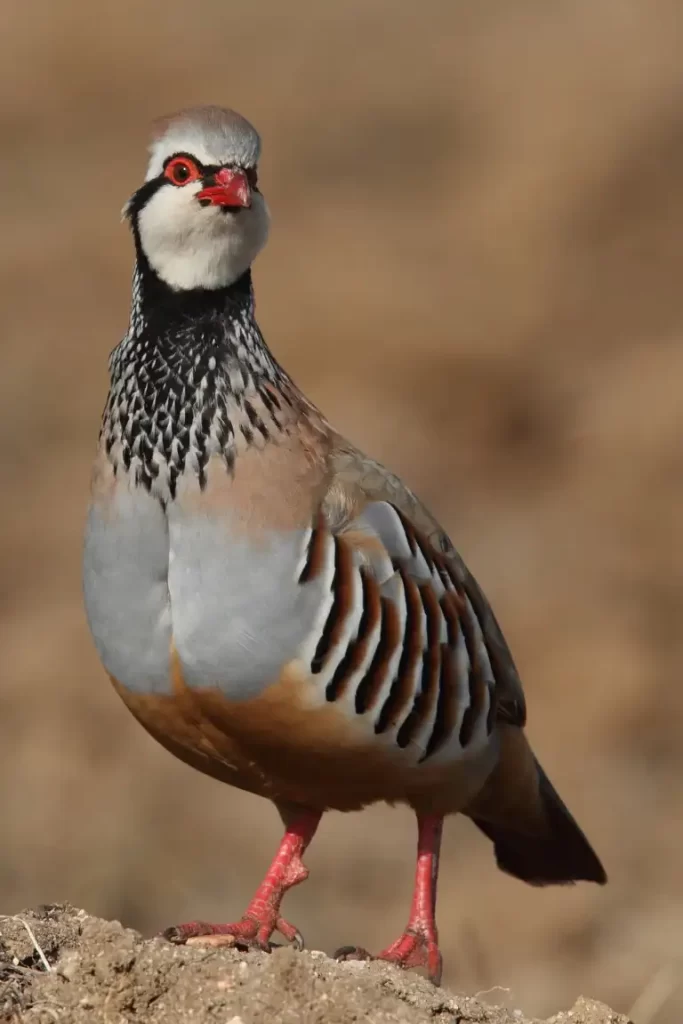
Red-legged partridges display a diverse diet consisting primarily of plant matter, including seeds, grains, and shoots.
Their ground-foraging behavior, coupled with the incorporation of insects and invertebrates, allows them to obtain the necessary nutrients for their survival and reproductive success.
By adapting their feeding habits to the seasonal availability of food, these remarkable birds demonstrate their ability to thrive in various environments and ensure their dietary needs are met.
Let’s delve into their diet and feeding habits to uncover more fascinating details about their food choices and foraging strategies.
Plant Matter as a Staple
The red-legged partridge relies heavily on plant matter as the main component of its diet. This includes a variety of seeds, grains, and shoots that are abundant in their natural habitats.
They have a remarkable ability to locate and extract these plant resources from the ground, using their strong beaks to peck at the soil and uncover their preferred food items.
Seeds and grains provide essential nutrients, energy, and sustenance for the partridges, supporting their overall health and well-being.
Foraging on the Ground
Red-legged partridges are primarily ground foragers, meaning they search for food on the soil surface rather than in trees or shrubs.
This foraging strategy allows them to exploit a wide range of food sources available on the ground, including fallen seeds, grasses, and other plant material. Their beaks are well-adapted for pecking and probing the soil, enabling them to efficiently extract seeds and grains from the ground.
This ground-foraging behavior also provides them with an opportunity to closely inspect their surroundings for any potential threats or predators.
Insects and Invertebrates
While plant matter forms the bulk of their diet, red-legged partridges also incorporate small insects and invertebrates into their meals, particularly during the breeding season.
Insects and invertebrates serve as a valuable source of protein and vital nutrients, essential for the growth and development of their young.
During this critical period, the partridges actively search for insects, beetles, worms, and other small invertebrates to supplement their diet and provide the necessary nourishment for their offspring.
Seasonal Variations in Diet
The diet of red-legged partridges can exhibit seasonal variations, influenced by the availability of different food resources throughout the year.
In warmer months, when vegetation is abundant, they may consume a greater proportion of fresh shoots, tender plants, and seeds.
As the seasons change and food availability fluctuates, the partridges may adapt their feeding habits to include a wider range of plant species and forage on a greater variety of seeds and grains.
Reproduction and Life Cycle
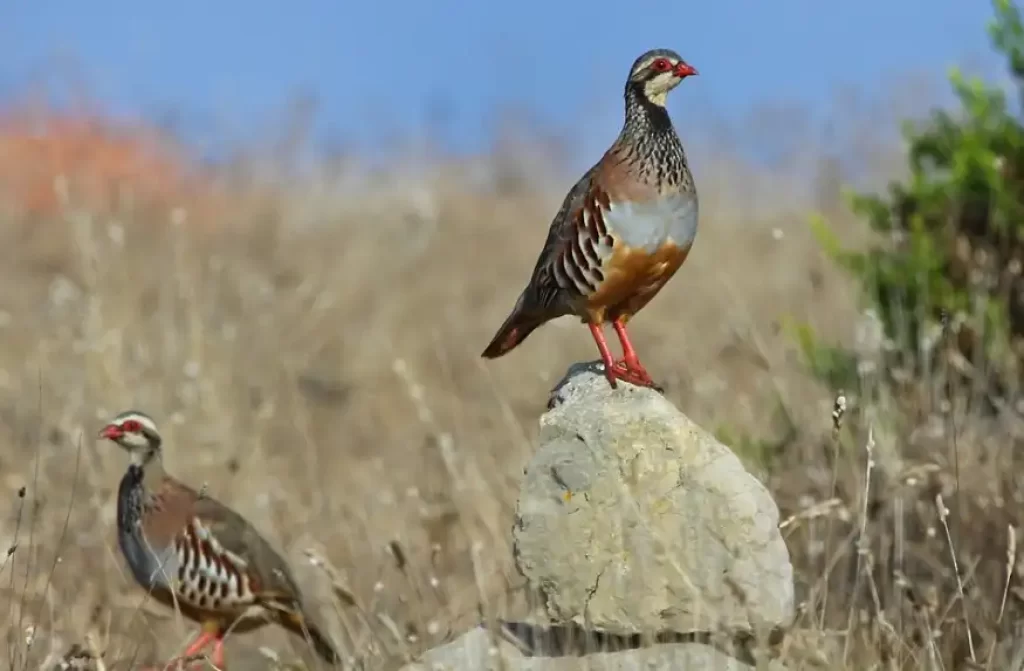
The reproductive cycle of red-legged partridges is a remarkable journey that begins with courtship displays, nest building, and egg laying. Through shared parental care, the incubation of eggs, and the development of precocial chicks, these birds ensure the survival and growth of their offspring.
As the chicks mature into adults, they carry on the legacy of their species by participating in the breeding cycle, contributing to the ongoing population of red-legged partridges in their habitats.
Let’s take a closer look at the partridge reproduction and the various stages they go through in their life cycle.
Breeding and Courtship Displays
Breeding in red-legged partridges typically takes place during the spring season, specifically between April and June. This is the time when males engage in elaborate courtship displays to attract females.
The male partridge showcases its vibrant plumage, which includes the distinctive reddish-brown coloration on the head, neck, and upper body.
Through wing-flapping and calling, the male seeks to capture the attention of a potential mate and establish a bond.
Nest Building and Egg Laying
Once a pair has formed, the female partridge takes on the responsibility of nest building. She selects a suitable location on the ground, often in dense vegetation or grasses, to create a nest that provides shelter and protection for the eggs. The nest is carefully constructed using twigs, leaves, and other materials found in the environment. The female then proceeds to lay a clutch of approximately 10 to 20 eggs, which are slightly larger than chicken eggs and have a pale cream or buff coloration with speckles.
Incubation and Parental Care
Both the male and female partridge contribute to the incubation of the eggs, taking turns to ensure their warmth and protection. The incubation period lasts for about 23 to 24 days, during which the parents carefully rotate the eggs to ensure even heat distribution and monitor their development. This shared parental care is crucial for the successful hatching of the eggs.
Hatching and Chick Development
After the incubation period, the eggs hatch, and the tiny hatchlings, known as chicks, emerge from their shells. Red-legged partridge chicks are precocial, meaning they are relatively independent and capable of walking and feeding shortly after hatching.
The parents guide and protect the chicks, teaching them essential skills for survival. The chicks gradually develop their feathers and grow in size, undergoing a period of rapid growth and maturation.
Juvenile to Adult Transition
As the chicks mature, they undergo various stages of development until they reach adulthood. During this transition, they acquire their characteristic red legs and develop the vibrant plumage that distinguishes them as red-legged partridges.
The process of reaching sexual maturity takes several months, and once attained, the partridges are ready to engage in the breeding cycle themselves, continuing the perpetuation of their species.
Predators and Conservation of Red-legged partridges
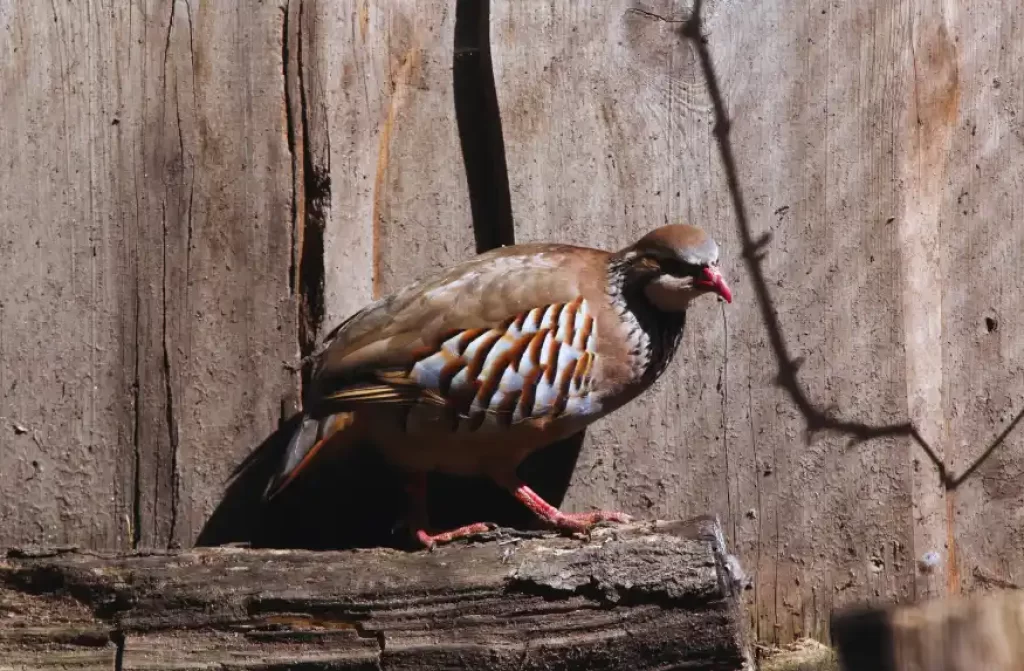
Red-legged partridges, just like any other bird species, have their fair share of challenges in the wild. They face threats from predators that consider them a tasty meal, including cunning foxes, stealthy birds of prey, and crafty mammals like stoats and weasels. These predators pose a constant danger to both adult partridges and their precious eggs and adorable chicks.
But predators aren’t the only concern for these charming birds. The loss and degradation of their natural habitats have a significant impact on their populations.
The expansion of agriculture and intensified farming practices have led to the destruction of vital habitats for the partridges.
The transformation of once lush grasslands and scrublands into farmlands has disrupted their nesting sites and limited their access to food resources. It’s no wonder their breeding success and overall population numbers have suffered.
Thankfully, conservation efforts are underway to protect our red-legged partridge friends and their habitats. Dedicated organizations and initiatives are working hard to restore and preserve the habitats they need to thrive.
They advocate for sustainable land management practices that are friendly to both the partridges and the environment. By creating and maintaining suitable conditions, these efforts ensure that these beautiful birds have enough food, shelter, and safe spaces to call home.
But it’s not just about taking action behind the scenes. Spreading the word and raising awareness about the importance of conserving these birds is key.
Through education and outreach programs, we can engage communities, landowners, and policymakers in the cause. By helping them understand the vital role that red-legged partridges play in maintaining healthy ecosystems, we can inspire action and change.
Together, we can encourage responsible land management practices and promote the preservation of diverse habitats, ensuring a brighter future for these captivating birds.
By managing predator populations, conserving their habitats, and spreading the love for red-legged partridges, we can make a real difference.
Protecting these birds isn’t just about preserving their beauty; it’s about safeguarding the delicate balance of nature and preserving the rich tapestry of life that surrounds us. Let’s join forces and ensure that future generations can still marvel at the sight of these delightful birds in their natural habitats.
Frequently asked questions (FAQ)
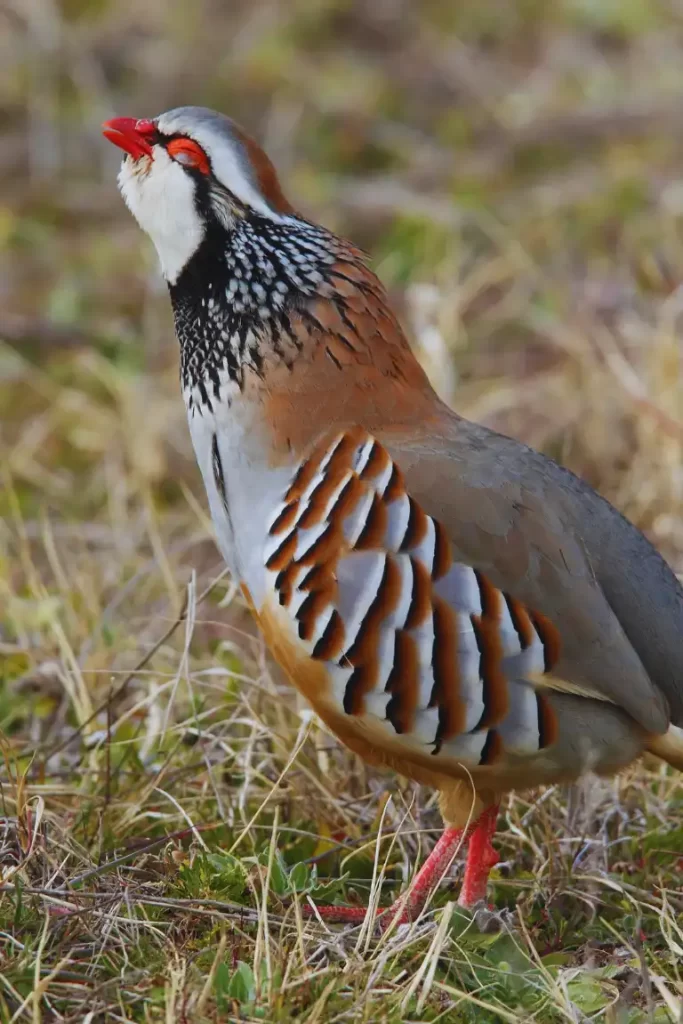
Can red-legged partridge fly?
Yes, the red-legged partridge is capable of flying, although its flight is generally limited to short distances. When disturbed or threatened, it will often prefer to run and take cover rather than relying on flight as its primary means of escape.
However, if necessary, it can take to the air, using its rounded wings to propel itself for short-distance flights.
While it may not possess the same strong flying capabilities as some other bird species, it still demonstrates enough agility and wing power to navigate its environment effectively.
Do partridges live in pear trees?
The association of partridges with pear trees originates from the popular Christmas carol “The Twelve Days of Christmas.” In the song, the gift “partridge in a pear tree” symbolizes the first day of Christmas. However, in reality, partridges do not have a strong natural affinity for pear trees specifically.
Partridges are ground-dwelling birds that prefer habitats such as farmlands, grasslands, scrublands, and open areas with suitable cover for nesting and foraging. While they may occasionally be found near trees, including fruit trees like pears, their natural habitat is not limited to or dependent on pear trees.
How long do red-legged partridges live?
Red-legged partridges have an average lifespan of about 2 to 3 years in the wild. However, under favorable conditions and with reduced predation risks, they can live up to 5 years or more.
Factors such as habitat quality, availability of food, and the presence of predators can influence their survival and longevity. In captivity, where they are protected from natural predators and provided with suitable care, red-legged partridges can live up to 10 years or even longer.
How many eggs does a red-legged partridge lay?
A female red-legged partridge typically lays a clutch of around 10 to 20 eggs. However, the exact number of eggs can vary depending on factors such as environmental conditions and available resources.
The female carefully selects a suitable nesting site on the ground, often hidden in dense vegetation or grasses, where she will lay and incubate her eggs.
Both parents take turns to incubate the eggs, ensuring their warmth and protection until they hatch, which usually takes around 23 to 24 days.
How big is a red-legged partridge?
Red-legged partridges are medium-sized birds, measuring approximately 30 to 35 centimeters (12 to 14 inches) in length. They have a robust build and rounded bodies. The males and females are similar in size, with slight variations depending on the specific subspecies.
On average, they weigh around 400 to 600 grams (14 to 21 ounces). Their wingspan typically ranges from 45 to 50 centimeters (18 to 20 inches). While not the largest of birds, red-legged partridges are known for their striking appearance and vibrant plumage.
References:
For further information and to explore more about red-legged partridges, the following references provide valuable resources:
- Red-legged partridge Wikipedia article: The Wikipedia article on red-legged partridges provides a comprehensive overview of the species, including details about their habitat, distribution, behavior, and conservation status. Visit the article at: Link to Wikipedia article
- Red-legged partridge on The IUCN Red List site: The International Union for Conservation of Nature (IUCN) Red List provides a detailed assessment of the conservation status of the red-legged partridge. It includes information on population trends, threats, and conservation measures. Access the information at: Link to IUCN Red List
- Xeno-canto bird call: To listen to the distinct vocalizations of red-legged partridges, the Xeno-canto website offers a collection of recordings contributed by bird enthusiasts worldwide. You can access recordings of their calls and vocalizations at: Link to Xeno-canto bird call





